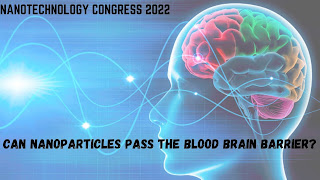Can nanoparticles pass the blood brain barrier?
After getting into the body, nanoparticles will reach the
organs through circulation. moreover, counting on their characteristics, like
size, shape, and chemical reactivity, they will cross the barrier, or they will
reach the brain through nerve fiber transport on the first cranial nerve.
Nanoparticles square measure tiny sized (1-100 nm) particles derived from
transition metals, silver, copper, aluminum, silicon, carbon and metal oxides
that may simply cross the barrier (BBB) and/or turn out harm to the barrier
integrity by sterilization epithelial tissue semipermeable membrane porousness.
Our experimental and calculated results steered that the optimum size of
nanoparticles for delivery into the brain via this mechanism would be five to
six nm in our system.
The blood–brain barrier restricts the passage of pathogens,
the diffusion of solutes within the blood, and enormous or deliquescent
molecules into the bodily fluid, whereas permitting the diffusion of
hydrophobic molecules (O2, CO2, hormones) and tiny non-polar molecules..
Nanoparticles possess monumental potential as diagnostic imaging agents and
hold promise for the event of multimodality agents with each imaging and
therapeutic capabilities. Yet, a number of the foremost promising nanoparticles
demonstrate prolonged tissue retention and contain significant metals. This
presents serious issues for toxicity. The barrier may be a cellular, compound
structure composed of epithelial tissue cells, pericytes and astrocytes in
direct contact with brain tissue. The BBB may be a compound structure following
the brain's labyrinth of vasculature.. This paper presents a radical discussion
of the physiological aspects of nanoparticle clearance, specializing in urinary
organ mechanisms, moreover as provides an outline of current analysis work
clearance of specific kinds of nanoparticles and nano-sized macromolecules, as
well as dendrimers, quantum dots, liposomes and carbon, gold, and silica-based
nanoparticles. giant molecules don't have the BBB simply. Low supermolecule
(fat) soluble molecules don't penetrate into the brain. However, supermolecule
soluble molecules, like barbituate medication, chop-chop cross through into the
brain.
Steroid hormones square measure thought to freely diffuse
across the barrier (BBB) thanks to the predominant ''simple diffusion'' model
of their transport across cell membranes. Microbubbles may be safely injected
intravenously, and once they reach the barrier the centered ultrasound makes
the bubbles expand and contract among the blood vessels. This makes them
quickly additional pervious, permitting drug molecules within the blood to pass
into brain tissue.



Comments
Post a Comment